Tales From the Wild Side
Summer 2021
Board of Directors
President Ilka Milne
Vice-President Mike Hammond
Secretary Gaby Emond
Treasurer Henry Van Ael
Committees
Newsletter Ilka Milne & Bob Saunders
Website Ilka Milne & Bob Saunders
Events Ilka Milne & Bob Saunders
Boardwalk Ahlan Johanson & Mike Hammond
Publicity Henry Miller & Ilka Milne
Stewardship Liaison Gaby Emond
Where are the bluebirds?
Article by Henry Miller (Fort Frances Times July 9)
Where are the bluebirds? Our expectations were that it would be another great year because of last year’s phenomenal success with an abundance of bluebirds nesting in our many bluebird houses. Usually by mid-May many are already nesting but sadly we saw only two nesting pairs thus far this year. Bluebirds, as well as tree swallows have thrived in hot, dry conditions before, so where have all our bluebirds gone?
Wondering what had happened, we contacted Bill Read, the president of the Ontario Eastern Bluebird
Society (OEBS). He suggested that many had probably perished in the ice storms that ravaged the southern states this past winter. Other species, such as the tree swallows were not affected as they spend the winters in Mexico instead.
In May of this year, volunteers began monitoring the established bluebird trails in our area. They counted 109 pairs of tree swallows, 4 chickadees, 7 wrens, 1 northern flying squirrel, but found only 2 bluebirds that were nesting in the boxes. Bluebirds interesting enough do not nest near one another, but will tolerate tree swallows even if their nest is built on the very same post. They are known to be quite a shy bird and whenever a predator or even a volunteer checking the bluebird houses approaches, they usually always fly away before they can be seen. If they have not detected the danger coming before hand and can no longer fly away undetected, they then try to hide by crouching down at the back of their nest.
Bluebirds construct their nests mostly of grasses in which the female then lays 4-6 eggs that are blue in colour, although sometimes they can be white instead. They are known for keeping their nests very clean by removing all fecal matter and egg shells, carrying it out and dropping it far away from their nest. The bluebird sits on her eggs for 14-16 days before the young bluebirds finally hatch after which both adults are then involved with feeding the nestlings until they fledge (leave the nest) usually occurring about two weeks later.
In direct contrast to the bluebirds, the tree swallows prefer to nest close together so that they can chase intruders away with help from birds in the adjacent nests. By driving at the enemy one at a time, these birds actually scare most predators away. Tree swallows are also much better at hiding in their nesting boxes should the need arise because their nests are composed of many large feathers, not just grass which they then easily can hide behind. Tree swallows lay a slightly greater number of eggs than the bluebirds, usually five but sometimes even 6 or 7. The incubation period for their eggs is slightly longer lasting 14-17 days and the nestlings then leave their nests in 15-17 days. Although swallows are plentiful this year, they sometimes take a year or two to find new boxes which is probably why our volunteers did not see many of them nesting.
The nesting boxes must be cleaned out yearly in the fall. As the nest is pulled out it can become very dusty, so always be sure to stand upwind so you don’t breathe in the dust. Birds, like most wildlife can carry diseases. Hornets or wasps sometimes occupy these nesting boxes as well. These insects can become quite upset when one opens the box and breaks their nest, so watch out!
Although those who constructed bird houses may be a little disappointed this year because of the low bluebird population, looking after birdhouses is still a great activity! Not only does it get a person outside in our great outdoors, it also makes for a great conversation piece. Happy trails everyone!
Night Sky
NGC 7023 THE IRIS NEBULA
Article by Fred Pugh
NGC 7023 also known as The Iris Nebula was discovered by the English astronomer William Herschel on October 18.1794 in the constellation Cepheus (figure 1). Cepheus is a circumpolar constellation at northern latitudes meaning it is visible all year round but is highest in the sky in the fall. The Iris Nebula shines at magnitude 6.8 and has an angular size of 18 arc minutes, slightly larger than half the width of the full moon. The central star of the nebula is easy to see in binoculars but the nebula itself is a difficult catch, even with a small telescope. A 200mm lens on a Canon DSLR mounted on a tracking mount recorded the image below (figure 2).
.
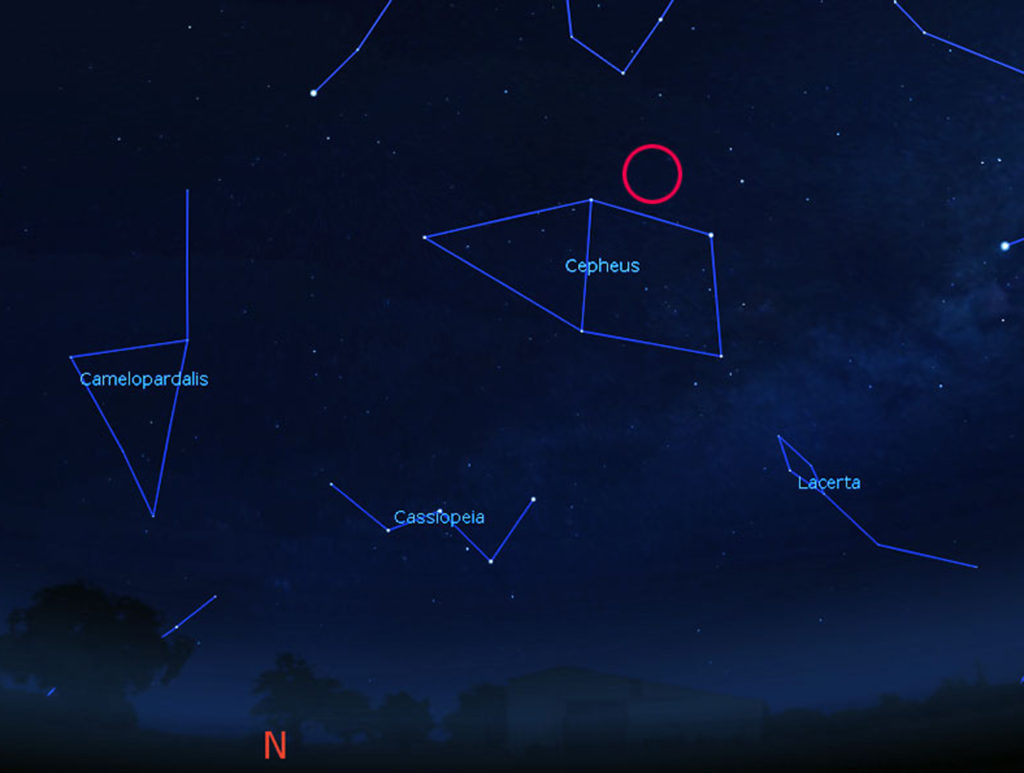
The Iris Nebula Nebula derived its name due to its resemblance to the iris flower. It lies at a distance of1,400 light years and is about 6 light years across. The Iris is a reflection nebula which means that its beautiful glowing blue color comes from the scattered light of its central star called SAO 19158. A reflection nebula glows because it is made up of extremely small particles of solid matter that is from 10 to 100 times smaller than typical dust particles on Earth. Light is diffused around these tiny particles creating a second hand glow that is usually bluish. There is also plenty of dark interstellar dust surrounding this nebula which blots out the stars behind. Astronomers are interested in studying the IrisNebula because there are unknown chemical compounds here but they believe them to be hydrocarbon based. This is important in the understanding of how various ingredients combine to form new stars.
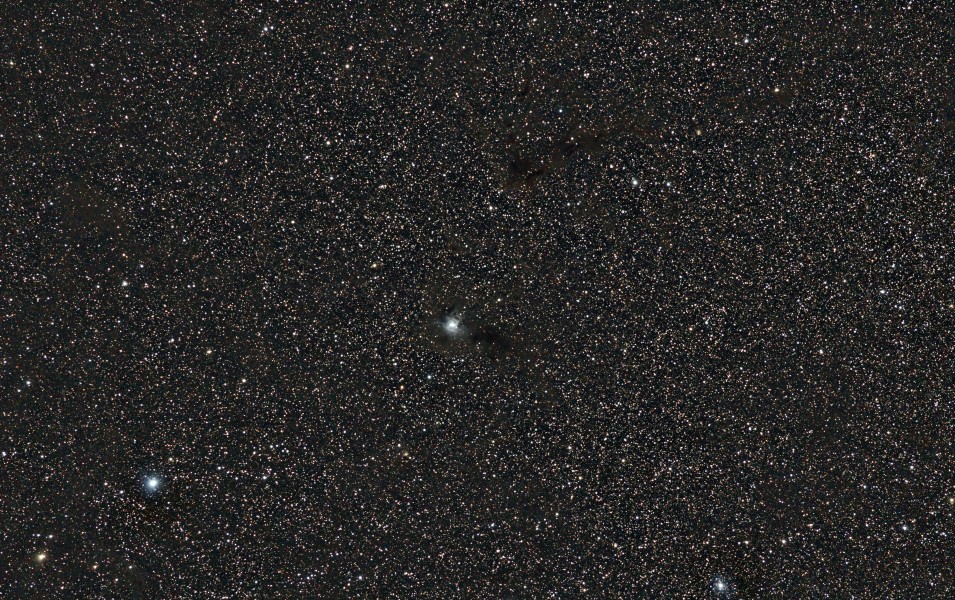
I took this photo (figures 3, 4) of NGC 7023, The Iris Nebula on August 4, 2018. The sky was good but there was a half moon rising late in the night. The moon did not have a great impact on the photo because the Iris Nebula is a relatively bright object and I limited my exposure time to 2 1/2 minutes to keep the sky from washing out too badly. I was able to get most of my light frames before the moon started to rise. The photo was not framed properly and a little of the dark dust lane is cut off at bottom left. I recently went back to re-process this photo using new techniques and was able to improve on the final result. I would definitely like to shoot this one again in a darker sky and using a longer exposure to bring out more of the faint nebulosity.
My work flow for creating this photo is as follows:
Telescope – Stellarvue SVA130T 5.1” Apochromatic Refractor
Focal length – 650mm
Focal ratio – f5
Camera – SBIG STF 8300C
Camera Temperature – set to -22C
Mount – Celestron CGEM DX
Light Frames – 18 at 2.5 minutes each
Dark Frames – 10 at 2.5 minutes eachFlat Frames – 10 at .01 second each
Dark Flat Frames – 10 at .01 second each
Inspected all frames for tracking errors and other problems, all were kept
Converted all frames from RAW to FITS files
Stacked in deepskystacker to reduce noise and enhance signal
Imported into Photoshop to stretch data, smooth remaining noise, enhance color and sharpen

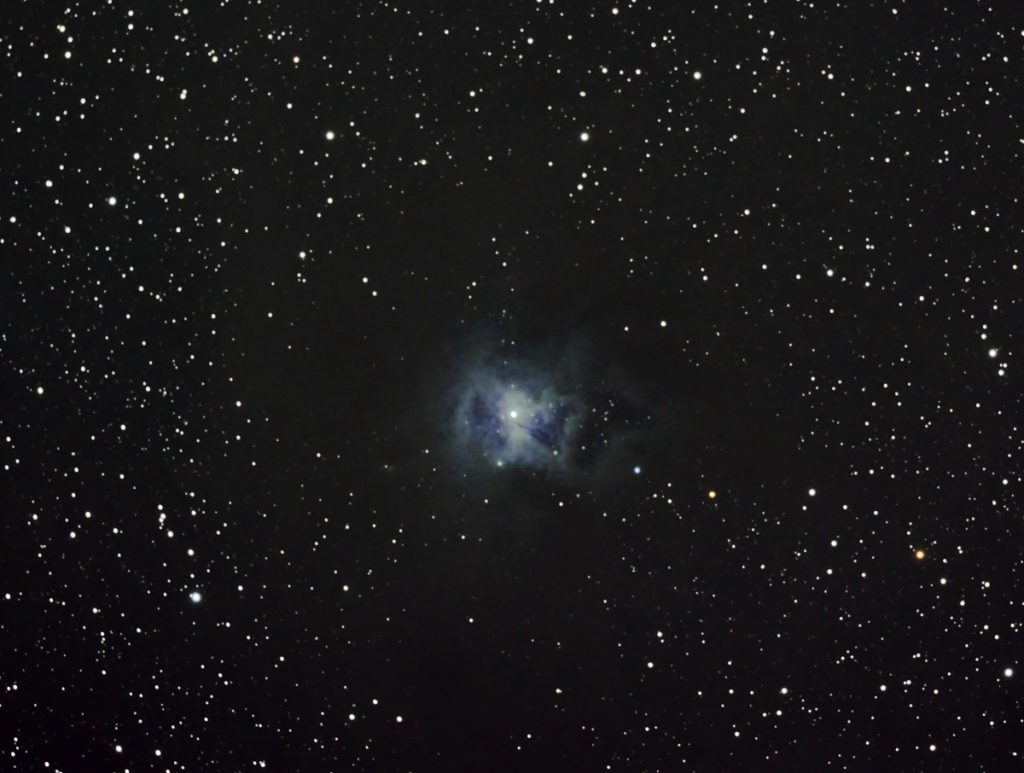
NGC 6960 THE VEIL NEBULA
Article by Fred Pugh
The Veil Nebula is the remnant of a supernova explosion and is regarded as one of the finest examples in the sky. It was discovered on September 5, 1784 by William Herschel and is found in the constellation Cygnus the Swan (figure 1) at a distance of about 2,100 light years. Its name was derived from the delicate, filamentary, draped and woven like structures that resulted from this cosmic explosion that occurred about 8000 years ago. The Veil Nebula is part of a much larger nebula called the Cygnus Loop (figure 2) that spans 3 degrees in the sky or 6 full moon widths. The actual size of the Veil is estimated to be 110 light years long. With a magnitude of 7, it is notoriously difficult to see because its light is spread over a large area. Some people claim to be able to see The Veil in binoculars but I have never seen it without taking a photograph. Because the nebula is right in the heart of the Milky Way, the light from countless stars overwhelms the faint light of the nebula.


Supernovas occur when stars that are much larger than our Sun use up all of their fuel and reach the end of their lives in a cataclysmic explosion. The star that formed the Veil nebula was about 20 times larger than the Sun. When a star explodes, a large expanding bubble sweeps up stellar debris along with other material in the surrounding area and forms a glowing nebula along the edge of the shock wave. The shock wave from this supernova is slamming into the surrounding dust and gas at approximately 600,000 kilometres per hour and creating temperatures in the millions of degrees. The Veil Nebula is composed mostly of hydrogen which causes the red color, oxygen which causes the blue and sulphur. A special sulphur 11 filter is needed to see the sulphur which will show as a green color. (figure 3).

I took this photo (figure 4) of NGC 6960, the Veil Nebula on August 11, 2018. It was very near the new moon and the sky was gorgeous, a night that amateur astronomers dream of. Everything went very well that night and I was happy with the data. If I had to do it over again, I would try a longer exposure which would brighten the nebula. I am constantly learning new techniques to improve my processing however so I recently decided to revisit this 2 year old data to see if I could improve on it and was pleasantly surprised with the result. I expect someday I will be back again to give it another try but for now this is my final Veil Nebula.
My work flow for creating this photo is as follows:
Telescope – Stellarvue SVA130T 5.1” Apochromatic Refractor
Focal length – 650mm
Focal ratio – f5
Camera – SBIG STF 8300C
Camera Temperature – set to -21C
Mount – Celestron CGEM DX
Light Frames – 15 at 5 minutes each
Dark Frames – 9 at 5 minutes each
Flat Frames – 10 at .01 second each
Dark Flat Frames – 10 at .01 second each
Inspected all frames for tracking errors and other problems, all were kept
Converted all frames from RAW to FITS files
Stacked in deepskystacker to reduce noise and enhance signal
Imported into Photoshop to stretch data, smooth remaining noise, enhance color and sharpen
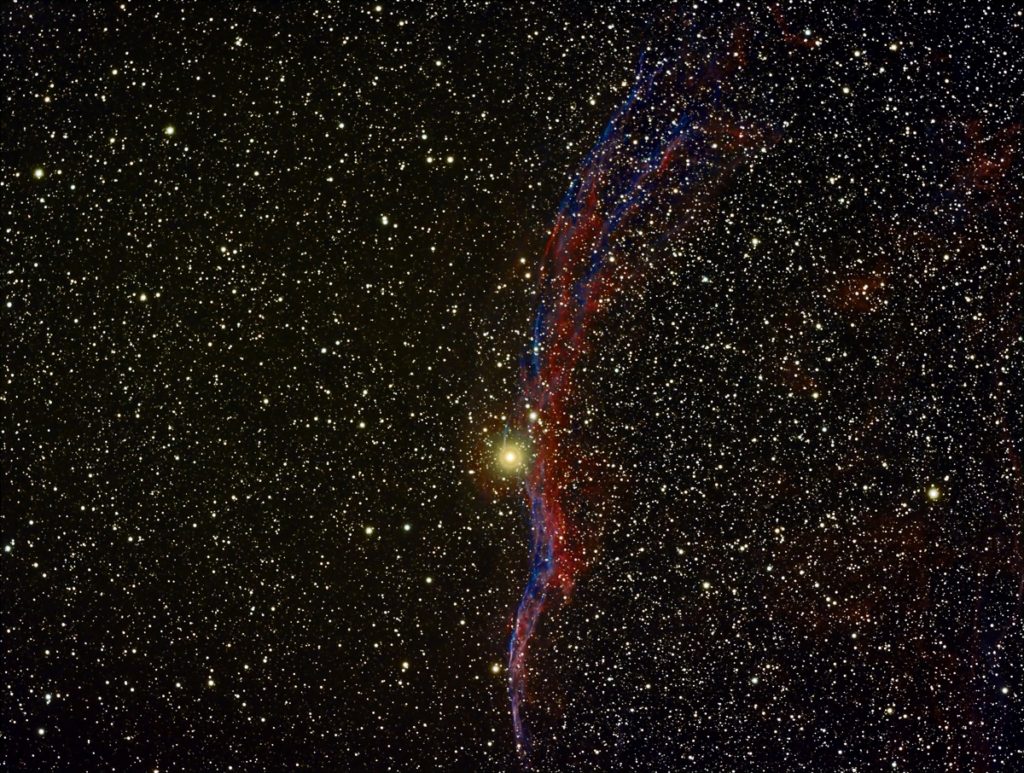
Poetry Corner
Summer Song William Carlos Williams
Wanderer moon
smiling a
faintly ironical smile
at this
brilliant, dew-moistened
summer morning,—
a detached
sleepily indifferent
smile, a
wanderer’s smile,—
if I should
buy a shirt
your color and
put on a necktie
sky-blue
where would they carry me?

Milkweed Helen Hunt Jackson
O patient creature with a peasant face,
Burnt by the summer sun, begrimed with stains,
And standing humbly in the dingy lanes!
There seems a mystery in thy work and place,
Which crowns thee with significance and grace;
Whose is the milk that fills thy faithful veins?
What royal nursling comes at night and drains
Unscorned the food of the plebeian race?
By day I mark no living thing which rests
On thee, save butterflies of gold and brown,
Who turn from flowers that are more fair, more sweet,
And, crowding eagerly, sink fluttering down,
And hang, like jewels flashing in the heat,
Upon thy splendid rounded purple breasts.
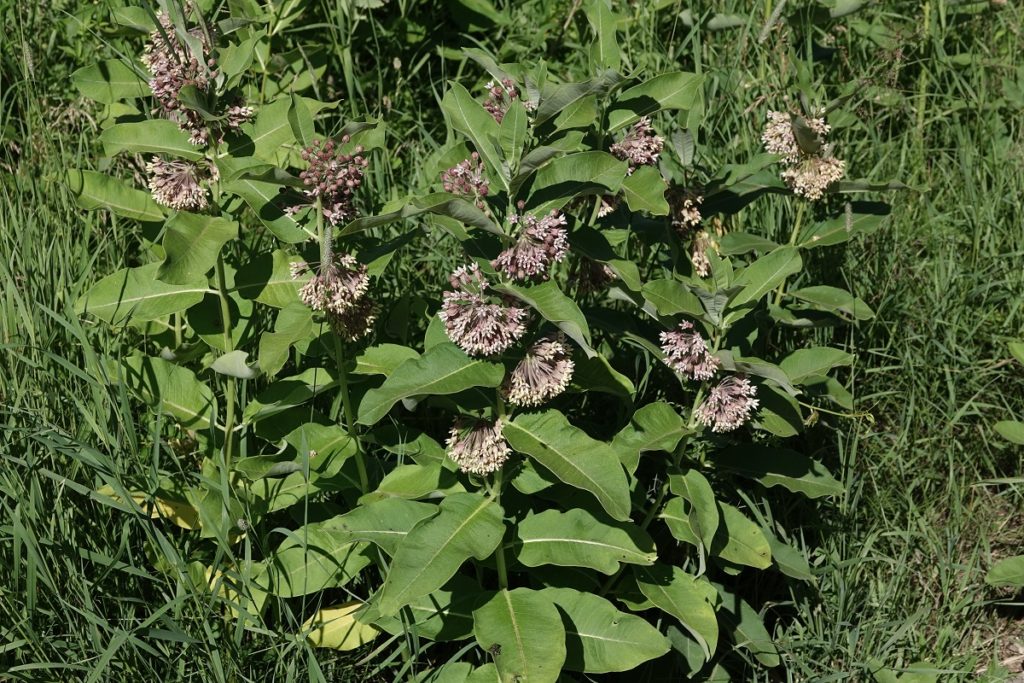

Common Milkweed ( Asclepias syrica) Photos Bob Saunders